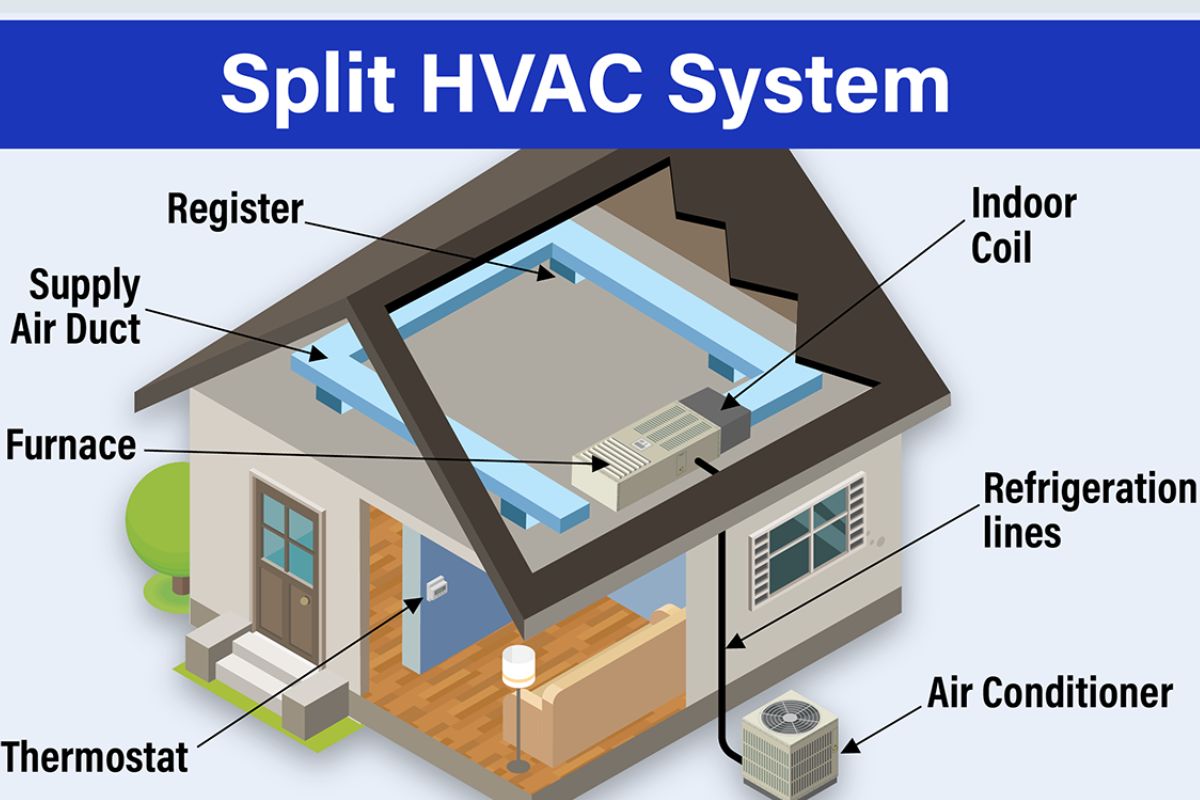The Rise of CO2 Heat Pumps in South Korea: A Sustainable Revolution in HVAC

Strong 8k brings an ultra-HD IPTV experience to your living room and your pocket.
Introduction
South Korea HVAC System Market is undergoing a significant transformation, driven by ambitious sustainability goals, increasing energy costs, and a growing awareness of environmental responsibility. Among the emerging technologies poised to reshape the landscape, CO2 heat pumps are gaining considerable traction, representing a revolutionary shift towards more sustainable and efficient heating and cooling solutions. This article delves into the rise of CO2 heat pumps in South Korea, exploring the driving forces behind their adoption, the key players involved, the technological advancements, and the future potential of this eco-friendly HVAC innovation.
Understanding CO2 Heat Pump Technology
At its core, a heat pump is a device that transfers heat from one place to another using a refrigerant as a working fluid. Traditional heat pumps often utilize synthetic refrigerants, many of which have a high Global Warming Potential (GWP), contributing significantly to climate change. CO2 (R744), on the other hand, is a natural refrigerant with an exceptionally low GWP of 1. This inherent environmental advantage, coupled with its excellent thermodynamic properties, makes CO2 an ideal refrigerant for next-generation heat pumps.
CO2 heat pumps operate on the same principle as conventional heat pumps but leverage the unique characteristics of carbon dioxide. They can efficiently extract heat from low-temperature sources like the air, ground, or water and elevate it to higher temperatures for heating purposes. Conversely, the cycle can be reversed for cooling. Notably, CO2 heat pumps excel at producing high water temperatures, making them particularly well-suited for applications like domestic hot water, district heating, and industrial processes.
Driving Forces Behind the Adoption of CO2 Heat Pumps in South Korea
Several factors are converging to fuel the increasing adoption of CO2 heat pumps in the South Korean HVAC market:
1. Stringent Environmental Regulations and Sustainability Goals: South Korea is committed to reducing its greenhouse gas emissions and achieving carbon neutrality. The government has implemented various regulations and initiatives to promote the use of environmentally friendly technologies, including phasing down high-GWP refrigerants. CO2 heat pumps, with their ultra-low GWP, directly align with these national sustainability objectives.
2. Growing Emphasis on Energy Efficiency: Energy security and high energy prices are significant concerns in South Korea. CO2 heat pumps are known for their high energy efficiency, especially in heating applications. Their ability to extract heat from renewable sources and deliver it efficiently translates to lower energy consumption and reduced operating costs for end-users.
3. Government Incentives and Support Programs: To encourage the adoption of clean energy technologies, the South Korean government has introduced various incentives and support programs for CO2 heat pumps. These may include subsidies, tax benefits, and preferential treatment in public procurement projects, making the technology more economically attractive.
4. Technological Advancements in CO2 Heat Pump Systems: Continuous research and development efforts are leading to significant advancements in CO2 heat pump technology. Manufacturers are developing more compact, efficient, and cost-effective systems for a wider range of applications, including residential, commercial, and industrial sectors. Innovations in compressors, heat exchangers, and control systems are further enhancing the performance and reliability of CO2 heat pumps.
5. Increasing Awareness of Climate Change and Environmental Concerns: Growing public awareness of climate change and its impacts is driving demand for eco-friendly products and solutions across various sectors, including HVAC. Consumers and businesses are increasingly seeking sustainable alternatives to traditional heating and cooling systems, making CO2 heat pumps a compelling choice.
6. Versatility and Wide Range of Applications: CO2 heat pumps offer a versatile solution for various heating and cooling needs. In South Korea, they are being explored and implemented in:
• Residential Buildings: Providing efficient space heating and hot water.
• Commercial Buildings: Serving heating, cooling, and hot water demands for offices, hotels, and retail spaces.
• Industrial Processes: Supplying high-temperature heat for various industrial applications, reducing reliance on fossil fuels.
• District Heating: Offering a sustainable and efficient heat source for large-scale urban heating networks.
Key Players and Market Landscape in South Korea
The South Korean CO2 heat pump market is witnessing the active participation of both domestic and international players. Key manufacturers and suppliers are investing in research, development, and marketing of CO2 heat pump technologies. These companies are offering a range of solutions tailored to the specific needs of the South Korean market. While specific market share data may fluctuate, prominent players known for their involvement in CO2 heat pump technology globally and potentially in South Korea include:
• Leading International HVAC Manufacturers: Companies with a global presence and a focus on sustainable technologies are likely introducing their CO2 heat pump solutions to the South Korean market.
• Domestic South Korean HVAC Companies: Local manufacturers are also recognizing the potential of CO2 heat pumps and are investing in developing and commercializing their own products.
• Specialized CO2 Heat Pump Suppliers: Niche companies with specific expertise in CO2 heat pump technology may also be entering or expanding their presence in South Korea.
The market landscape is becoming increasingly competitive, with players focusing on product innovation, energy efficiency, cost-effectiveness, and strong after-sales service to gain a competitive edge.
Technological Advancements Driving CO2 Heat Pump Adoption
Several technological advancements are contributing to the enhanced performance and wider applicability of CO2 heat pumps:
• Advanced Compressors: Innovations in compressor technology, such as scroll and rotary compressors specifically designed for high-pressure CO2 operation, are improving efficiency and reliability.
• Optimized Heat Exchangers: The development of highly efficient heat exchangers that can effectively transfer heat with CO2 as the refrigerant is crucial for maximizing system performance.
• Intelligent Control Systems: Sophisticated control systems that can optimize the operation of CO2 heat pumps based on real-time conditions and user demands are enhancing energy savings and comfort.
• Cascade Systems: In some applications, CO2 heat pumps are integrated into cascade systems with other refrigerants to optimize performance across a wider range of temperatures.
• Integration with Renewable Energy Sources: Combining CO2 heat pumps with renewable energy sources like solar thermal or geothermal energy further enhances their sustainability and reduces reliance on the electricity grid.
Challenges and Opportunities for CO2 Heat Pump Adoption in South Korea
Despite the significant potential and growing momentum, the widespread adoption of CO2 heat pumps in South Korea also faces certain challenges:
• Initial Investment Costs: CO2 heat pump systems can sometimes have higher upfront costs compared to conventional HVAC systems, which can be a barrier for some consumers and businesses. However, government incentives and long-term energy savings can help offset this.
• Technical Expertise and Training: The installation and maintenance of CO2 heat pump systems require specialized knowledge and training. Expanding the pool of qualified technicians is crucial for wider adoption.
• Awareness and Education: Raising awareness among consumers, installers, and policymakers about the benefits and capabilities of CO2 heat pump technology is essential for driving demand.
• Infrastructure Development: For large-scale applications like district heating, the development of necessary infrastructure to support CO2 heat pump systems is important.
However, these challenges also present significant opportunities:
• Market Growth Potential: The South Korean HVAC market is large and growing, offering a substantial market for CO2 heat pump technologies as sustainability becomes a priority.
• Innovation and Technological Leadership: South Korea has a strong track record of technological innovation. Investing in CO2 heat pump research and development can position the country as a leader in this emerging field.
• Job Creation and Economic Benefits: The growth of the CO2 heat pump industry can create new jobs in manufacturing, installation, maintenance, and related sectors, contributing to economic growth.
• Contribution to Climate Change Mitigation: Widespread adoption of CO2 heat pumps can significantly reduce greenhouse gas emissions from the heating and cooling sector, contributing to South Korea's climate change mitigation efforts.
The Future of CO2 Heat Pumps in South Korea
The future of CO2 heat pumps in South Korea looks promising. As the country intensifies its efforts towards carbon neutrality and energy efficiency, this sustainable HVAC technology is expected to play an increasingly vital role. Continued technological advancements, supportive government policies, growing environmental awareness, and decreasing costs will likely drive further adoption across various sectors.
Conclusion
CO2 heat pumps represent more than just an alternative HVAC solution; they signify a paradigm shift towards a more sustainable and environmentally responsible future for heating and cooling in South Korea. By harnessing the natural power of carbon dioxide, South Korea can pave the way for a greener and more energy-secure future.
Note: IndiBlogHub features both user-submitted and editorial content. We do not verify third-party contributions. Read our Disclaimer and Privacy Policyfor details.







